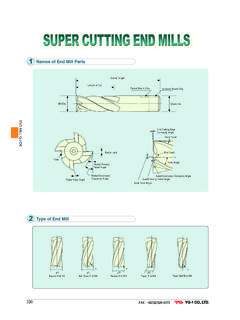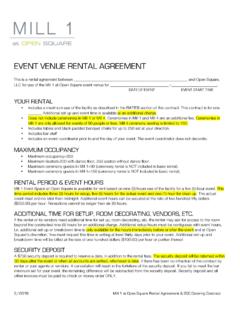Transcription of Wage Trends, 1800-1900
1 This PDF is a selection from an out-of-print volume from the NationalBureau of Economic ResearchVolume Title: trends in the American Economy in the Nineteenth CenturyVolume Author/Editor: The Conference on Research in Income and WealthVolume Publisher: Princeton University PressVolume ISBN: 0-870-14180-5 Volume URL: Date: 1960 Chapter Title: wage trends , 1800-1900 Chapter Author: Stanley LebergottChapter URL: pages in book: (p. 449 - 500) wage trends , 1800 1900 STANLEY LEBERGOTTBUREAU OF THE BUDGET like those architects, pupils of Viollet-le-Duc, who, fancying thatthey can detect, beneath a Renaissance rood-loft and an eighteenth-centuryaltar, traces of a Norman choir, restore the whole church to the state inwhich it probably was in the twelfth century. Swann's from the interest that inheres in any search for our nationalorigins, the economic trends of the nineteenth century have directrelevance to our own era. For one thing, this was a period of majorgrowth and change. Today's macro-economic analysis tends to focuson changes in resource use during only a few decades, usually whenrelatively slight shifts occurred aside from massive government inter-vention or incentive.
2 Data for the twentieth century must be intenselyaccurate, and analysis must range from the astute to the abstruse if weare to detect other causal factors and link them to changes in the nineteenth century, however, Herculean transformationsoccurred and the task of attributing cause to result is simpler.'A second aspect of special contemporary interest is the effectiveanalogy that this period offers for the dissection of Soviet economicchange and the study of underdeveloped nineteenthcentury surely constitutes a much more relevant historical analogy forsuch study than does the United States during the 1920's, or even theearly 1900's. Indeed, a period in which a large slave population was asignificant resource element and major political factor is particularlyappropriate for the study of Russian third aspect of contemporary relevance is the substantial extent ofgovernment intervention in the economic process by way of tariffprotection, Henry Clay's "American System," and so forth a traditionthat lapsed for a few decades early in this century but was reinvoked in1932 under the impact of twelve million present paper is divided into three sections.
3 In the first, a fewyeasty generalizations on the economics of the labor market are attemp-ted, using as a starting point the wage series developed in later point, mad here with respect to development over time, is identical with thatmade with respect to contemporary structural analysis by Trygve Haavelmo, AStudy inthe Theoryof Economic Evolution, North Holland Publishing Co., 1954, p. : The opinions expressed are purely personal, and this study has no connection withthe work of the Bureau of the PAYMENTSIn the second section (page 462), the main lines of wage rate changesduring the nineteenth century are adumbrated in so far as the presentdata reveal them (summarized in Table 2, page 462). The third section(page 471) offers detailed estimates for particular periods, industries,and occupations, together with an outline of the sources and methodsutilized to arrive at these Economics of the Labor MarketIMPACT OF DEMAND ON wage RATESThe impact of labor demand and supply on wage rates in the earlynineteenth century operated within institutional relationships set up bythe historical tradition.
4 Thus the consumption patternof the coloniesand the Confederation for manufactured goods was oriented towardproducts imported from England. When manufacturing developed inthe early nineteenth century, it was aimed at superseding did so by adopting English production patterns, technicalmethods, and almost inevitably once these were given by tendingtoward the characteristic English occupational Samuel Slater came to Rhode Island in 1790, he brought notmerely English equipment plans but English production patterns; forexample, the tradition of hiring large numbers of children for factorywork. The first operatives hired by Slater were seven boys and twogirls, aged between seven and In 1833, 50 per cent of theemployees in Slater's Steam Cotton Manufacturing Company This pattern was adopted in the early Rhode Island the tradition was not suited to American conditions of supply anddemand and fell upon infertile soil. With 20 per cent of adult employ-ment in cotton textiles in 1833, Rhode Island had 60 per cent of NewEngland's child , which became the leadingtextile and manufacturing state, filled only 10 per cent of the cotton milljobs with Early PeriodThe result of concentrated demands for labor and dispersed suppliesis most obvious in the early stages of industrialization.
5 The typicalcotton or wool manufactory in the first third of the century was, ofcourse, the American home with only a few workers. Most factories,too, had but few workers. Even by 1833 typical Massachusetts Clark, History of Manufactures in the United States, McGraw-Hill, 1929, ,p. Relative to the Statistics of Manufactures in the United States, Duff Green,1833, Vol. i, ; hereafter referred to as Documents, ona totaling of reports in Documents, trends , 1800-1900reported 12, 15, 101, 81, 28, 221, and 19 employees. Amidst theseLilliputians the giant cotton mills stand apart: the Lowell mills with290, 480, 826, and in the Merrimac Mill i ,443employees;and suchNew Hampshire firms as Great Falls with 1,382; New Market with 672,or Cocheco with 1, with the enormous size of these establishments was theneed to draw employees from some distance away. Local labor supplieswere nowhere near adequate. One result was the black "slaver's wagon"of New England tradition, recruiting labor for the mills.
6 The other wasthe distinctly higher wage rate paid by such mills in order to attractlabor from other towns and states. Humanitarian inclinations and therequirements of labor supply went hand in hand. Thus while hundredsof small plants in New York, in Maine, and in Rhode Island paid 30 to33centsa day to women and girls, the Lowell mills generally paid50 differential did not evidence differences in cost of living, orgenerally higher Massachusetts rates. It reflected primarily supply can best be seen by the fact that hundreds of women throughoutthe state were paid only 25 to 30 cents a day for weaving palm leaf hats,the same rate as was paid in other New England and Middle Atlanticstates. Female rates in Massachusetts shoe factories, typically small,and typically manufactories, also ranged from 25 to 30 cents. (We canderive a simple measure of the disutility and costs associated withworking in large factories, being far distant from home, and so forth,by comparing the 44 cent rate generally paid females in Massachusettscotton mills, or the 50 cents in the giant mills, with this 25to30 cent aday rate.)
7 In general the factory discipline commanded a premiumwage over home work and the putting-out impact of high demand is equally apparent in the rate paid tochildren in Rhode Island mills. Rhode Island accounted for 60 per centof all children employed in the New England cotton mills, and althoughits rate for females was among the lowest for any northeastern state, itsrate for children was well above the median for these states. The reverse of this pattern gives a strong confirmation. The demandWomen's factory earnings ran from $2 to $3 compared "to what might be earned intheir usual occupations at one dollar and a half per week." Albert Gallatin, Chairman,Memoir of the Committee Appointed by the Free Trade Convention, Philadelphia, September October 1831, 1832, p. 20. Cf. also Matthew Carey, Twenty-one Golden Rules to DepressAgriculture, Impede the Progress of Manufactures.. bya Pennsylvanian, Salem, 1824, andRemuneration for Female Labour, To the Editor of the New York Daily Sentinel, March 18,1830, in which Carey reports 1,100 women working for the Provident Society of Philadelphiain the winter of 1828 29 averaging 50 cents a week "recompense" according to Mary Queen,matron of the society.
8 Carey indicates a usual wage of $ a number of children employed in New Hampshire, Vermont, and possiblyConnecticut makes somewhat uncertain the reliability of the average for children in thosestates. They were therefore ignored in making this PAYMENTSfor male employment was nothing like as geographically concentratedas that for females, and the rates paid differed little among the severalnortheastern states. (Not that the whole level of wage rates was un-affected by these demands. One need only refer to the bitter protest ofRepresentative Hudson of Massachusetts, who flatly stated that factoryoperatives "were taken chiefly from the agricultural class, and when theywere withdrawn wages rose." 7)Once the labor supply had been recruited, and the level more or lessstabilized, the acute need for a differential passed. Although the data onthis point are exiguous, it appears that the wage rates paid the Lowellgirls dropped sharply after the initial period, from 67 cents in 1828 to50 cents a day in 1840 for weavers in one mill, and from 64 cents to55 cents over a briefer period in While rates forother occupa-tions showed different trends , the fact that an overwhelmingly largesegment of female employment was in the weaving group makes thisrate change FrontierA well-known aspect of demand is the impact of the frontier.
9 Al-though advice may have brought some young men to go West, theimpact of wage rates and incomes probably attracted many more. Thedifferentials between regions and states that still exist were even moremarked during the period of development. For labor had to be attractedhundreds and thousands of miles away from its source, whether thatsource was a homestead in Vermont or a ship landing in New rate paid farm labor (monthly with board) in Illinois was $12 ascompared with $8 to $9 for Ohio and Indiana in 1818 and 1830. Andthe frontier territory of Minnesota in 1850 paid rates 70 per cent abovemore settled Iowa, Missouri, and the East North Central classic case, of course, is California in the Gold Rush farm hands in 1850 earned $60 a month, 400 per cent abovethe rates paid in the Midwest. (Any further advantages accruing fromproximity to the mines are, happily, not measurable and, presumably,kept the rate from being still higher.) While the frontier may not havebeen closed until 1890, the gap in the wage rates reached a minimumshortly after the Civil War.
10 California rates fell by 30 per cent from1850 to 1870, while New England rates rose by 40 per cent. For theCongressionalGlobe, 1842,p. rates for weavers in the Merrimac mill appear in 1880 Census of the United Stales, , Joseph D. Weeks, Reporton the Statistics of Wages in Manufacturing Industries, ; hereafter referred to as the Weeks Report. For the other Lowell mill, cf. 1880 Census, , Reporton the Manufactures of the United States, CarrollD. Wright, FactorySystem of the United States, foliop. 576;hereafterreferred to as the Wright Report. Hegives 1828 figures for "two of the best known factories in Massachusetts" and 1836 figures"for the same factory." His language suggests that he may have been referring to theHamilton and Appleton mills, which were jointly run at one period, separated trends , 1800-1900next seventy-five years the two rates maintained a rough parity ofmovement, a gap only reappearing under the pressures of World War IIproduction and the second westward in the WestSouth Central frontier had also stopped their marked decline by 1870,moving parallel to other rates in subsequent versus Old SouthWhile it is difficult to make any exact calculation, the probabilitythat mere chance accounted for South Carolina's being the leader in theNullification Controversy of 1833 and the secession in 1861 is ten states with a generally southern orientation in 1833, andat least that many in 1861, the joint probability of the same state beingfirst to act at both dates is less than one in one hundred.















